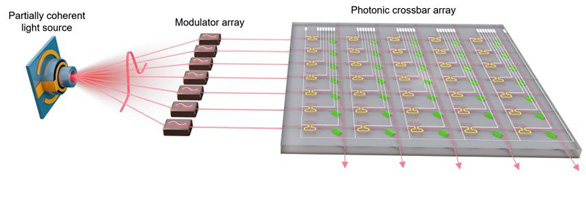09 Aug 2024
Innovation applies in certain optical applications, such as light-driven AI technologies.
Researchers from the University of Oxford, UK, along with collaborators from the universities of Münster, Heidelberg, and Ghent, contend that replacing lasers with less complex light sources can surprisingly boost performance in certain optical applications, such as light-driven AI technologies.They say that this discovery, described in Nature, “opens the way for cheaper, and less energy-intensive light sources to be used in applications that have typically relied on expensive, high-spec lasers.”
Professor Harish Bhaskaran, of the Department of Materials, commented, “We will also investigate whether this insight might apply to optical communications, particularly in the emerging optical interconnect technology space.”
Highly coherent lasers have been a foundation of modern applications such as optical communications, lidar remote sensing, and medical imaging technologies. Thus, it was natural to assume that using more coherent light sources enhances system performance and device functionalities.
This new discovery challenges this conventional wisdom and reveals that low coherence light sources can actually function better in specific cases, such as a photonic AI accelerator – an emerging technology where photons are used instead of electrons to perform AI computations.

Diagram showing how once partially coherent light source can supply a whole photonic computing chip.
The team used a partially coherent light source by harnessing a narrow portion of the spectrum of incoherent light produced by an electrically-pumped erbium-doped fiber amplifier. This partially coherent light was evenly split and distributed into different input channels for a parallel AI computational array. Using such a light source, the parallelism of AI computation is surprisingly enhanced by N times in a photonic accelerator with N input channels.
Test case – identifying Parkinson’s disease
As a test case, the team used this system to identify Parkinson’s disease patients by analyzing how they walked, achieving a classification accuracy of over 92%. The team also demonstrated how a simple system using only one partially coherent light source with nine input channels could perform high-speed AI tasks at around 100 billion operations per second. Normally, such a speed could only be achieved in a coherent photonic AI accelerator with multiple separate coherent lasers.
Ultimately, removing the need to add additional light sources could prove transformational in boosting computational power, as first author Dr Bowei Dong at the Department of Materials, University of Oxford, explained: “The benefit of using poorer light sources has a scaling effect. You can run your AI models 100 times faster compared to a laser system, if the photonic accelerator scales to 100 input channels.”
Professor Harish Bhaskaran, Department of Materials, University of Oxford and co-founder of Salience Labs, who led the work said: “While this work showcases the use of such partially coherent light in some emerging areas of photonic computing, we will in future also investigate whether this insight might apply to optical communications, particularly in the emerging optical interconnect technology space.”
| © 2024 SPIE Europe |
|